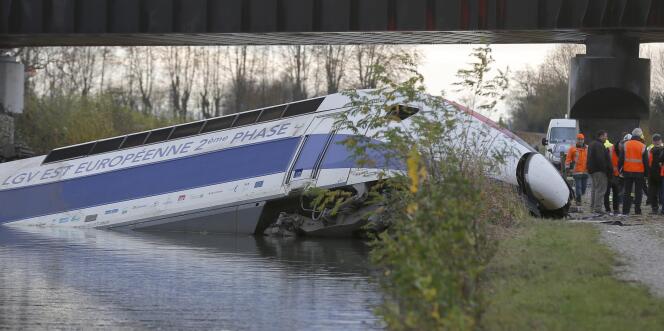“At the time of the accident, I was standing, there was a strong sideways jolt, then I felt a strange and unfamiliar sensation. » Julien Fay is a TGV repairman, he was in the penultimate carriage of the train which, on November 14, 2015, was carrying out tests on the final portion of the high-speed line between Paris and Strasbourg before its opening to the public. He recounts the moment when the train, arriving too quickly on a curve, overturned. “I felt my feet lift quickly, I saw that the whole train was lifting, a colleague tried to catch a computer that was slipping, and then I said to myself: “Fuck, we’re getting out.” What we experienced that day is indescribable. »
From Tuesday April 30 to Friday May 3, several survivors of the TGV Est accident still managed to describe, at the helm of the 31e criminal chamber of the Paris court, what a derailment looked like at nearly 250 km/h. With raw and striking words, the polar opposite of the verbal contortions and empty formulas uttered the previous days by representatives of the SNCF and its two subsidiaries – Systra and SNCF Réseau – tried for “involuntary homicide”, and who denied any responsibility .
Fifty-three people were on board the damaged TGV: 18 employees of SNCF, Systra and SNCF Réseau busy with the tests, and 35 guests – all family members of the former – authorized to attend. Eleven people died: nine employees, two guests. The other forty-two were more or less seriously injured.
“I see my wife, she doesn’t answer”
For three days, the court heard some survivors recount the crash of the accident, the bodies thrown into the seats and against the walls, the shattering of glass, the deafening noise of the cars rubbing against the ground, the water and the mud rushing into the three wagons having finished their journey in a canal below the track, the cold and the fear of dying drowning which seize their still living occupants, the dead silence then the first moans. And visions of horror.
“I see my wife, her head buried in a seat, she does not respond. I see my sister-in-law at the back of the train, doubled over, with her back broken in the other direction”, says Patrick Rolland, shaken with tears. He had been invited to the tests, with his wife and children, by his brother Alain, an employee of Systra, who died in the accident. Thomas Rolland, his son, aged 13 at the time, talks about the “pieces of human flesh” everywhere around him. Lydie Guyot tells the story “unbearable pain” that she feels just after the disaster: “With each breath, I feel my ribs go “clack-clac”. »
You have 62.07% of this article left to read. The rest is reserved for subscribers.
